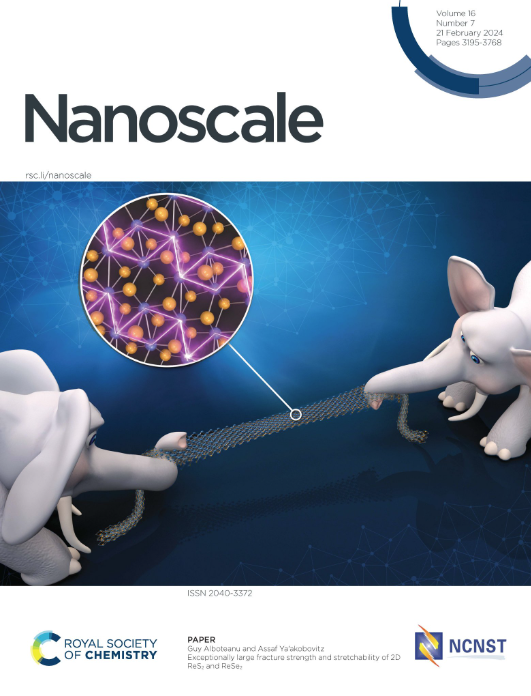介孔二氧化硅纳米颗粒上聚乙二醇链动力学的核磁共振研究,以减少非特异性结合
IF 5.8
3区 材料科学
Q1 CHEMISTRY, MULTIDISCIPLINARY
引用次数: 0
摘要
介孔二氧化硅纳米颗粒(MSNs)由于其可调节的表面特性和高生物相容性,在各种生物科学应用中引起了极大的关注。通过硅烷化学与亲水聚合物如聚乙二醇(PEG)进行功能化,通常用于减少非特异性蛋白质吸附并增强生理环境中的稳定性。然而,表征表面配体,特别是在水环境中,仍然是一个关键的挑战。在这项研究中,我们利用了一套全面的核磁共振(NMR)技术,包括1H定量核磁共振(qNMR)、扩散有序光谱(DOSY)和弛豫时间测量(T1和T2),来研究聚乙二醇链在MSN表面的动力学和构象。我们的分析揭示了PEG接枝密度和链迁移率之间的关系,表明在更高密度下,PEG接枝密度向密集的刷状构象过渡。DOSY和T2实验使共价结合的PEG从松散吸附的分子中分化出来。该方法为评估表面功能化效果、确保聚乙二醇化纳米颗粒的质量和一致性提供了一种可靠的方法。此外,我们研究了核磁共振衍生参数与蛋白质吸附阻力之间的关系,表明密集排列的“密刷”构象的PEG链可以有效减少人类血清白蛋白的非特异性吸附。这些发现为聚乙二醇化msn的设计提供了有价值的见解,支持提高生物医学应用的质量、一致性和功能。本文章由计算机程序翻译,如有差异,请以英文原文为准。

NMR studies of PEG chain dynamics on mesoporous silica nanoparticles for minimizing non-specific binding
Mesoporous silica nanoparticles (MSNs) have garnered significant attention for diverse bioscience applications due to their tunable surface properties and high biocompatibility. Functionalization with hydrophilic polymers like poly(ethylene glycol) (PEG) via silane chemistry is commonly employed to reduce non-specific protein adsorption and enhance stability in physiological environments. However, characterizing surface ligands, particularly in aqueous environments, remains a key challenge. In this study, we utilized a comprehensive suite of nuclear magnetic resonance (NMR) techniques, including 1H quantitative NMR (qNMR), diffusion-ordered spectroscopy (DOSY), and relaxation time measurements (T1 and T2), to investigate PEG chain dynamics and conformation on MSN surfaces. Our analysis revealed the relationship between PEG grafting density and chain mobility, demonstrating a transition to a dense brush conformation at higher densities. DOSY and T2 experiments enabled the differentiation of covalently bound PEG from loosely adsorbed molecules. This approach provided a robust method for evaluating the efficacy of surface functionalization, ensuring the quality and consistency of PEGylated nanoparticles. Furthermore, we examined the relationship between NMR-derived parameters and protein adsorption resistance, demonstrating that densely packed PEG chains with a “dense brush” conformation can effectively reduce non-specific adsorption of human serum albumin. These findings provided valuable insights into the design of PEGylated MSNs, supporting improved quality, consistency, and functionality for biomedical applications.
求助全文
通过发布文献求助,成功后即可免费获取论文全文。
去求助
来源期刊

Nanoscale
CHEMISTRY, MULTIDISCIPLINARY-NANOSCIENCE & NANOTECHNOLOGY
CiteScore
12.10
自引率
3.00%
发文量
1628
审稿时长
1.6 months
期刊介绍:
Nanoscale is a high-impact international journal, publishing high-quality research across nanoscience and nanotechnology. Nanoscale publishes a full mix of research articles on experimental and theoretical work, including reviews, communications, and full papers.Highly interdisciplinary, this journal appeals to scientists, researchers and professionals interested in nanoscience and nanotechnology, quantum materials and quantum technology, including the areas of physics, chemistry, biology, medicine, materials, energy/environment, information technology, detection science, healthcare and drug discovery, and electronics.
 求助内容:
求助内容: 应助结果提醒方式:
应助结果提醒方式:


